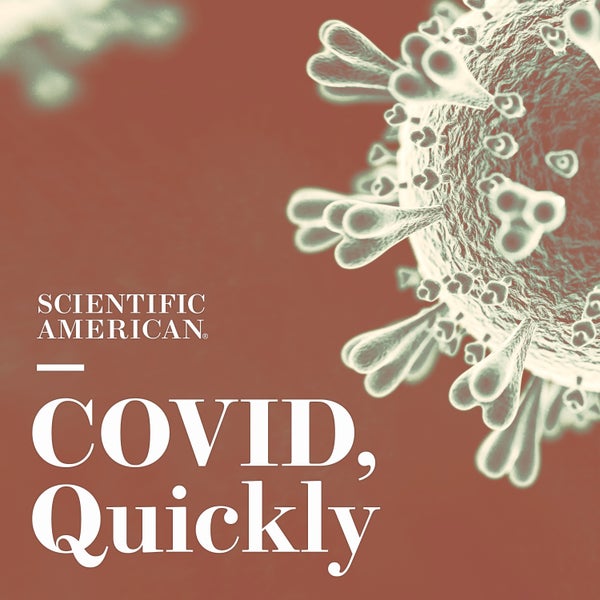Tanya Lewis: Hi, and welcome to COVID, Quickly, a Scientific American podcast series!
Josh Fischman: This is your fast-track update on the COVID pandemic. We bring you up to speed on the science behind the most urgent questions about the virus and the disease. We demystify the research and help you understand what it really means.
Lewis: I’m Tanya Lewis.
On supporting science journalism
If you're enjoying this article, consider supporting our award-winning journalism by subscribing. By purchasing a subscription you are helping to ensure the future of impactful stories about the discoveries and ideas shaping our world today.
Fischman: I’m Josh Fischman.
Lewis: And we’re Scientific American’s senior health editors. Today we’re going to explain how COVID deaths have been seriously undercounted in many parts of the U.S.
Fischman: And we’ll discuss the raging debate over the origins of the pandemic virus: a wild animal or a sloppy human lab?
We know that COVID has caused an unthinkable number of deaths—more than half a million in the U.S. alone. But you’ve been looking at new research, Tanya, and could the true number of deaths during the pandemic be even larger?
Lewis: Yes, scientists have looked at the number of “excess deaths,” or deaths beyond the amount you’d expect in a typical year, and showed that there were far more deaths than usual in 2020 at the national and state levels. In a new preprint study, Andrew Stokes, a professor of population health at Boston University, and his colleagues calculated excess deaths at the county level. They found big disparities in how these deaths were attributed to COVID in different parts of the country.
Rural counties, especially ones in the South and West, had the highest rates of excess deaths not attributed to COVID. Some of these were likely COVID deaths that were misattributed to other illnesses (especially early on, when COVID testing was limited). Others may have been deaths from other causes that indirectly resulted from the pandemic’s social and economic fallout.
Fischman: Why did this miscount occur so often in rural areas?
Lewis: In cities, deaths often happen in hospitals, where doctors or medical examiners pronounce the cause of death. But in rural areas, the job is often done by coroners or other elected officials who don’t have a medical background. Stokes and his team hypothesize that in some cases, a coroner’s political views might have influenced their likelihood of attributing a death to COVID.
Regardless of what caused the deaths, it’s important to understand the true impact the pandemic has had on communities—especially those that were disproportionately affected by it.
The big, noisy argument this week is about the origin of the coronavirus that causes COVID. Was SARS-CoV-2 a spillover from wild animals? Or did it escape from a lab in China? You’ve written about this dispute, Josh. What’s your take on all this?
Fischman: In my opinion, Tanya, we need less opinion—and more facts. Both of these theories are largely fact-free. They are both built on assumptions and circumstantial evidence. That hasn’t stopped politicians and journalists from sounding off.
There are piles of assumptions behind the lab-leak idea. One is that the virus has unique features that could only have been genetically engineered in a lab. That’s not been proven. In fact, one feature actually appears in a bunch of related coronaviruses.
Another notion is that the Wuhan Institute of Virology, in the same city where the virus was first detected, was sloppy: “Perhaps the lab brought the virus in, then infected workers carried it to the community. The lab took its database of collected viruses off-line. Perhaps it did so to hide this link.” Labs can be sloppy. But there’s no direct evidence for this sequence. We’ve got nothing showing that SARS-CoV-2 was in the lab before the outbreak.
Lewis: Good point. Many scientists think a natural spillover event from wildlife is a likely scenario. But that requires some assumptions, too, right?
Fischman: Yep, it’s this: In nature, billions of coronaviruses are constantly mutating, and perhaps one went from bats into another animal. Then it jumped to humans. It’s an assumption because nobody has found the mystery animal.
Lewis: That does seem like a big missing piece.
Fischman: It is. But it takes a long time to find these missing links. After the original SARS disease broke out in 2003, it took 14 years for scientists to find bats that first had the virus. After HIV was detected, it took almost 20 years to find its route through chimpanzees. Still, you’re right. It’s a gaping hole.
Lewis: Is anyone out there taking the right approach to figuring out where SARS-CoV-2 came from?
Fischman: Yes, Joe Biden is. Last week the Director of National Intelligence announced U.S. spy agencies thought all these ideas fell way short of proof. So Biden told them to go back to the drawing board, gather more facts and give us a report in 90 days.
Also, respected researchers published a letter in the journal Science saying both ideas needed to be considered, and scientists need to collect better evidence. It’s the same message: stop bloviating opinions based on assumptions and go get some facts.
Lewis: You think that’s going to give us an answer?
Fischman: I hope so. Probably not as fast as talking heads want. Remember how many years it took for those other diseases. But we should have a more informed idea of coronavirus origins if we stick to the evidence.
Lewis: Now you’re up to speed. Thanks for joining us.
Fischman: Come back in two weeks for the next episode of COVID, Quickly! And check out SciAm.com for updated and in-depth COVID news.
[The above text is a transcript of this podcast.]

